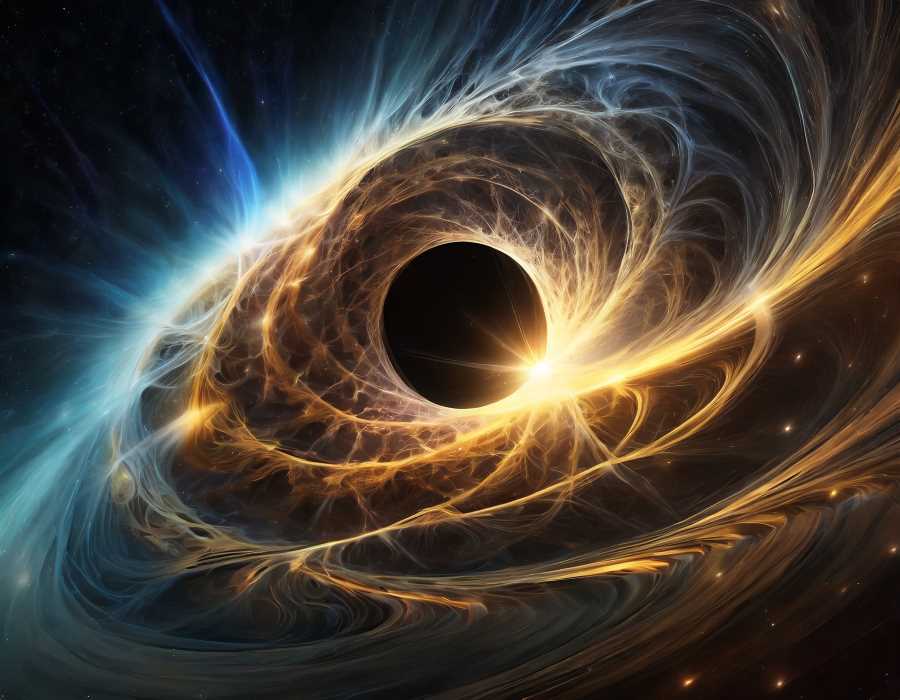M87* Black Hole Reveals its Magnetic Secrets
EHT's global collaboration unveils magnetic fields and particle dynamics around M87* black hole using circular polarization. This breakthrough sheds light on matter consumption and jet formation, showcasing the consortium's pivotal role in unraveling cosmic mysteries.

In the vast expanse of the Virgo galaxy cluster, approximately 55 million light-years from Earth, lies a celestial marvel that has captivated the attention of scientists around the globe—the supermassive black hole M87*. The latest revelations from the international Event Horizon Telescope (EHT) collaboration have illuminated the magnetic fields and particle interactions around M87*, offering unprecedented insights into the enigmatic nature of these cosmic giants.
The EHT, a groundbreaking initiative uniting over 300 scientists from Africa, Asia, Europe, and the Americas, employs an Earth-sized virtual telescope composed of synchronized instruments scattered worldwide. In a recent publication in the Astrophysical Journal Letters, the EHT researchers unveiled their findings on the circular polarization of light, shedding light on the magnetic fields and particle types enveloping M87*.
The study, led by scientists including Alejandro Cruz Osorio from the Instituto de Astronoma (IA) and Laurent Loinard from the Instituto de Radioastronoma y Astrofsica (IRyA), both affiliated with UNAM. It marks a significant milestone in unraveling the mysteries surrounding black holes.
Circular polarization of light, a phenomenon rarely studied in astronomical observations, allowed researchers to discern the direction in which the electric field rotates. This novel approach revealed valuable information about the magnetic fields and particle dynamics surrounding M87*, providing clues about the behavior of matter falling into the black hole.
Cruz Osorio emphasized the importance of analyzing magnetic field structures using polarized light, stating, “Analyzing the structure of magnetic fields near the supermassive black hole M87* using polarized light is crucial for understanding the nature of the black hole and the hot gas around it.” The study confirmed that the magnetic field's strength near M87* plays a pivotal role in regulating the inflow of matter.
The spiral structure inferred from these magnetic fields aligns with theoretical predictions, suggesting highly magnetized gas. This magnetization is believed to contribute to the acceleration of material in M87's characteristic jet—a phenomenon central to understanding how black holes consume and expel matter.
The EHT's contributions extend beyond scientific inquiry, fostering international collaboration and providing a platform for students and early-career researchers to engage with some of the world's leading scientists. Loinard highlighted the global nature of the collaboration, describing it as “a truly enriching experience.”
The EHT's journey began with the groundbreaking image of a ring of plasma near the event horizon of M87* in 2019. Subsequent findings in 2021, revealing the organized and intense magnetic fields through linear polarization, set the stage for the recent breakthrough in circular polarization.
The challenges faced by the research team were immense, as the circularly polarized signal was 100 times weaker than the unpolarized data used to create the first black hole image. Detecting such a faint signal amidst the noise was likened to hearing a conversation amid the deafening noise of a construction site.
To overcome these challenges, the research team developed innovative methods for reconstructing a polarized image from limited and noisy data provided by the EHT. Rigorous testing, including comparisons with simulated data, was crucial in refining these methods.
The EHT collaboration's ultimate goal is to capture the most detailed images ever obtained of black holes, creating a virtual telescope the size of Earth. Supported by substantial international investment, this endeavor combines telescopes worldwide, using new techniques to observe radio waves and achieve unparalleled angular resolving power.
The participating telescopes, including ALMA in Chile, APEX in Chile, and the Alfonso Serrano Large Millimeter Telescope in Mexico, collectively form a powerful instrument for probing the cosmic depths. The EHT consortium, comprising 13 institutions, stands at the forefront of astronomical exploration, pushing the boundaries of our understanding of the universe.
In this cosmic dance of light and gravity, M87* continues to reveal its secrets, thanks to the collaborative efforts of scientists worldwide. The EHT's exploration of circular polarization marks a significant step forward, offering a clearer picture of the magnetic fields and particle dynamics surrounding these cosmic behemoths, bringing us closer to unlocking the profound mysteries of the universe.




